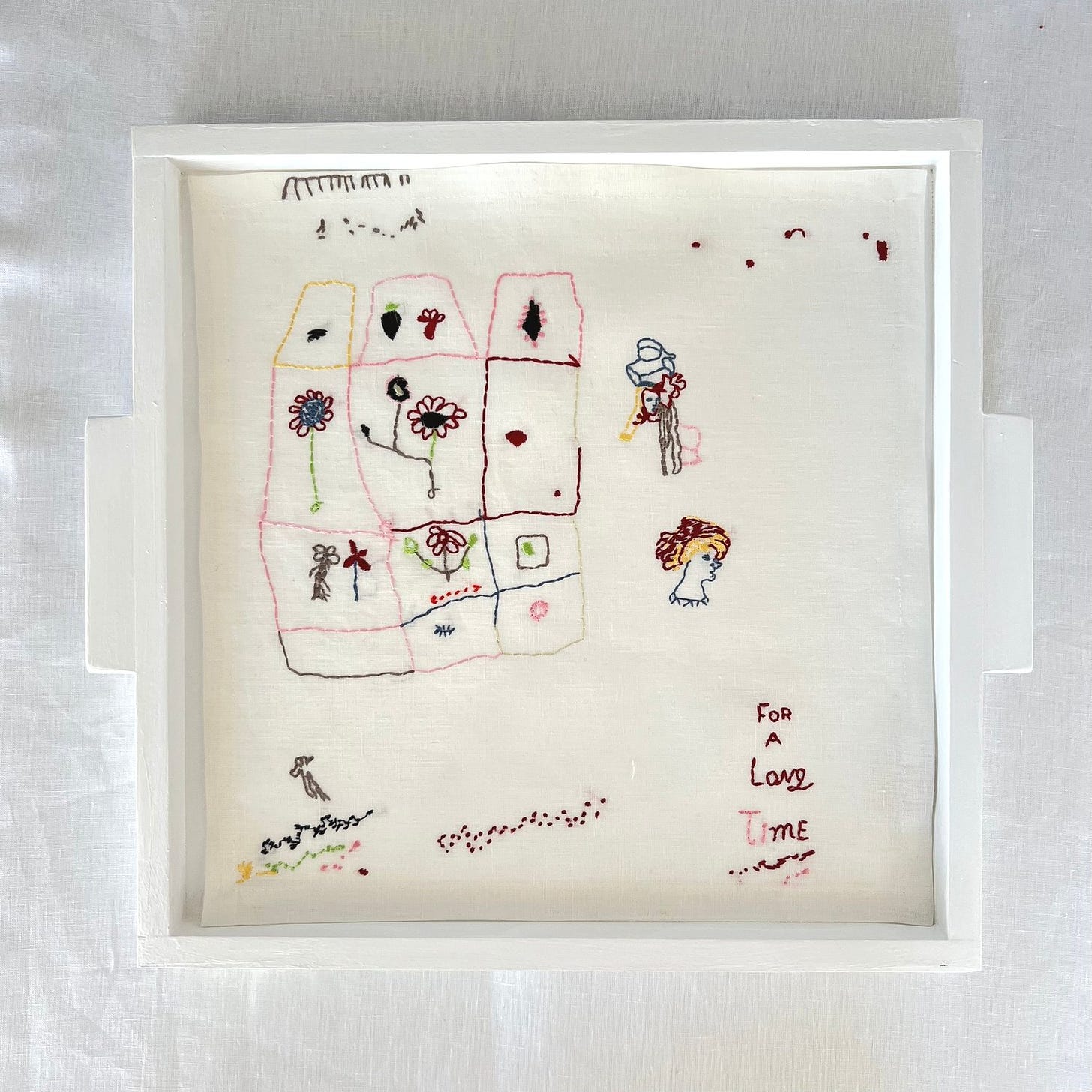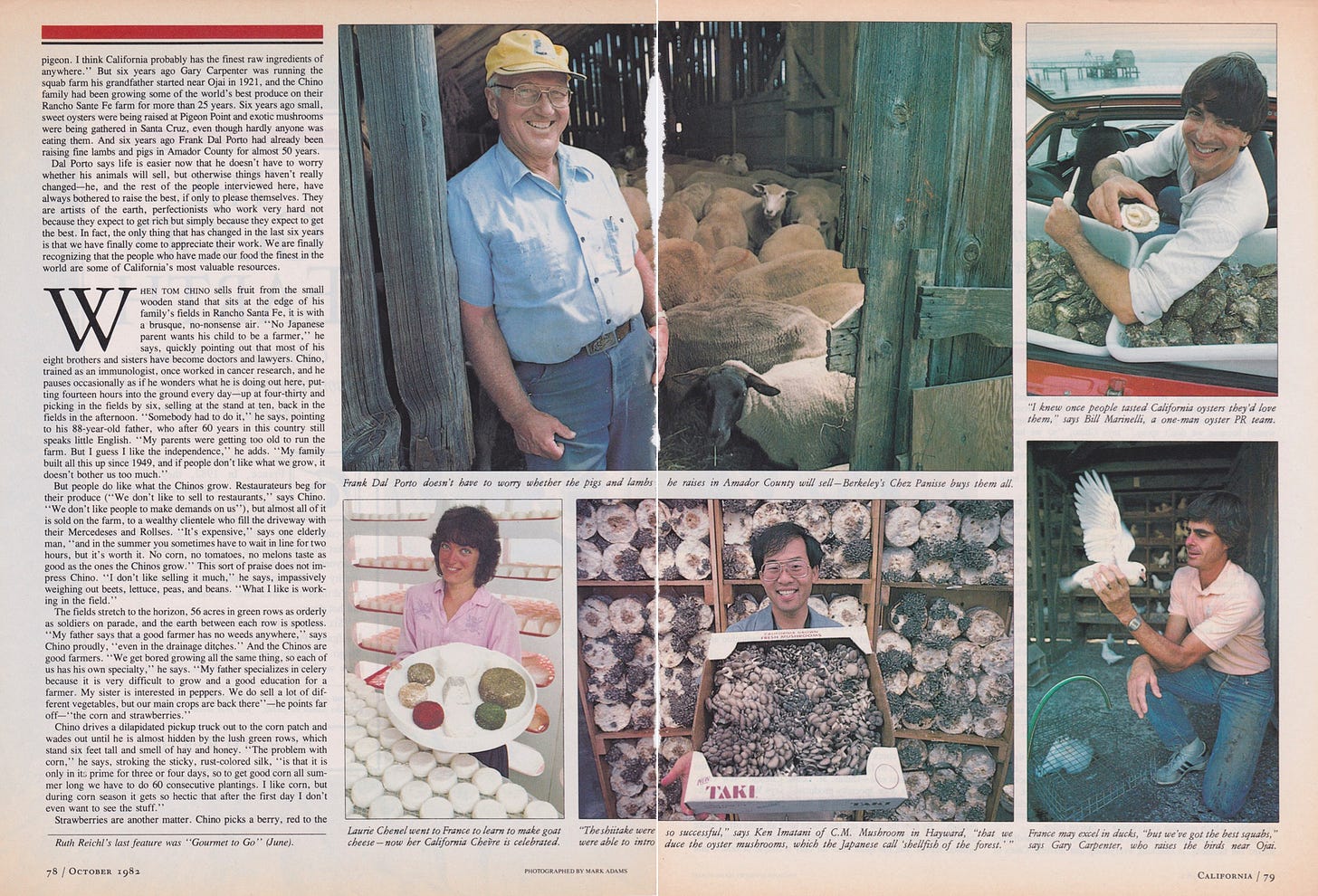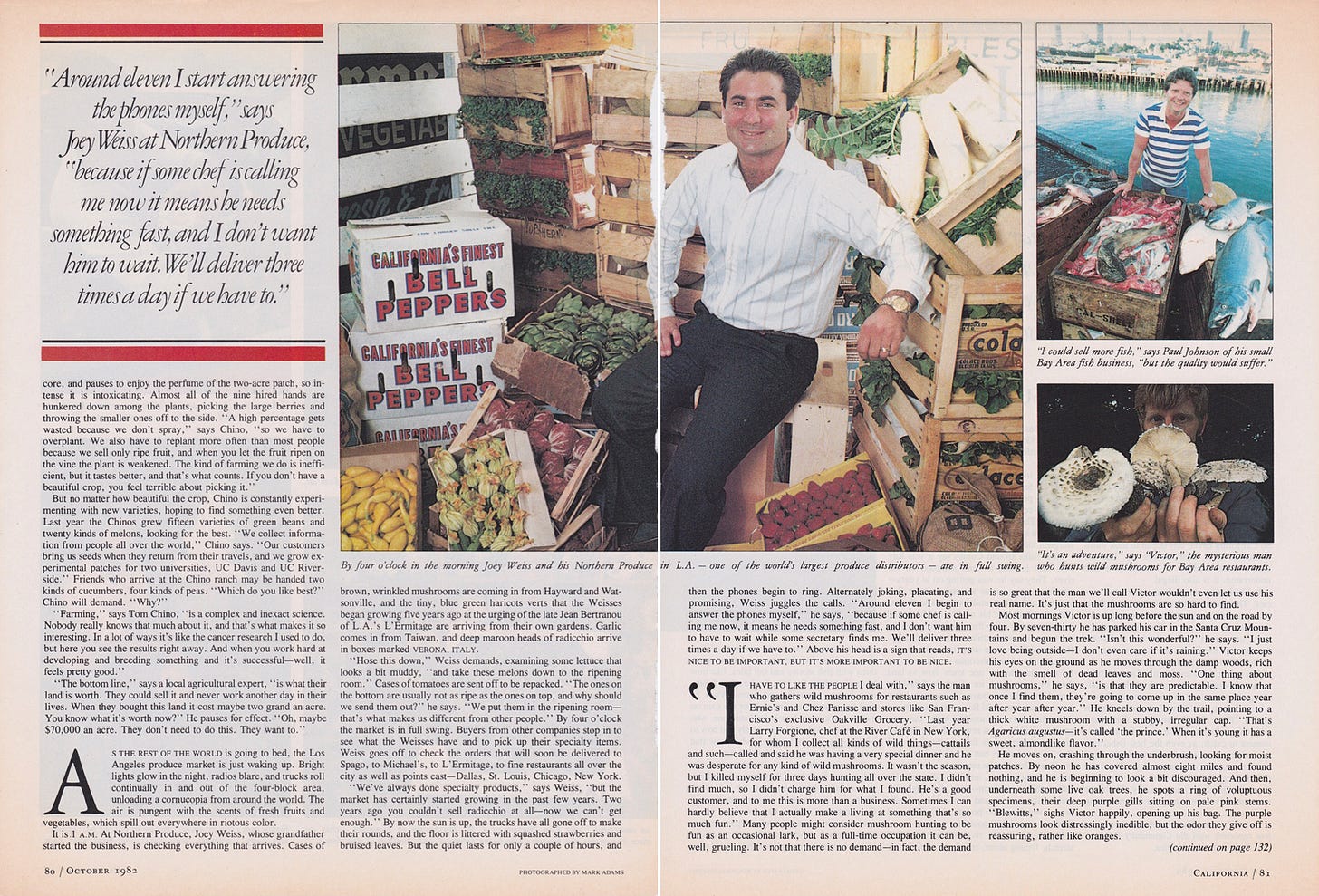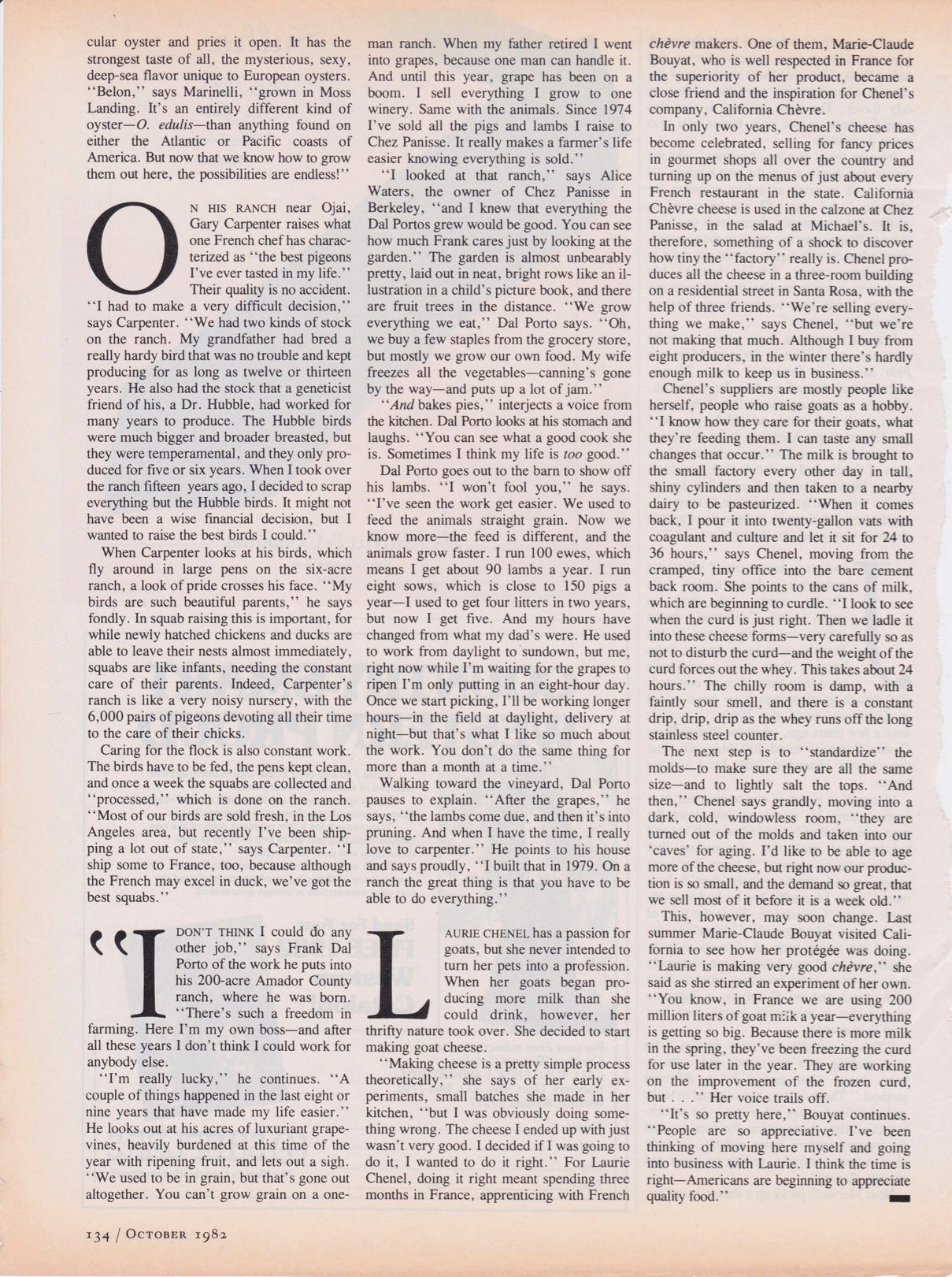California Dreamin'
When great food was hard to find; how to make a perfect Caesar salad - and one really great gift.
Maira Kalman’s latest creation just landed in my inbox yesterday, but I immediately put in an order. From the moment I began reading Maira’s book, Max Makes a Million to my six year old son, I’ve been in love with her work. (And Nick still owns the Max the Dog doll I bought him 27 years ago.)
Maira calls her latest creation a coziette; it’s a little wooden tray topped with a piece of embroidered linen. (I bought the Proust version.) She suggests putting a cup of tea on it and setting it next to your bed. I think it would be very happy sitting on my desk. I know it would make me happy to have it there. But I can also think of at least a dozen friends who would be thrilled to get this
Writing this article was so much fun! I got to meet a lot of my heroes, but it wasn’t always easy. When I called the Chino family saying I was writing an article about California’s finest food products and wanted to visit their ranch, Tom Chino said, “We don’t talk to the press,” and hung up the phone. Desperate, I called Alice Waters to ask if she would take me along the next time she went to Rancho Santa Fe. We spent what turned out to be one of the best weekends of my life there.
Laurie Chenel, who was then producing America’s only goat cheese, wasn’t all that eager for publicity either. Neither was Gary Carpenter, who was raising what one French chef called, “the best birds in the world.” And the mushroom forager I spoke with wouldn’t even let me use his name. The thing is, none of these people were trying to be rich or famous; they just loved their work.
Looking back, however, what astonishes me is how revolutionary all this was in that time before farmers markets and artisan bread and the great American cheese revival. These people gave me hope that the industrialization of American food was not inevitable; their descendants still do.
Caesar Salad
Considering its popularity, it’s very sad to find so many despicable Caesar Salads floating around the universe. Lifeless little bits of lettuce overwhelmed by a powerfully gummy dressing, dusted with sawdust posing as cheese and garnished with nasty little shards of fish won’t make anybody’s day. We can do better.
There’s a reason why the Caesar, which was invented in a Tijuana hotel in the twenties, was an immediate hit with its glamorous Hollywood clientele. The salad was crisp and refreshing, substantial enough to make a meal, and enormous fun to eat.
The Caesar soon turned into a California classic, provoking a long-standing dispute within the Cardini family as to which brother deserves the credit for it. There has never been any dispute, however, about the fact that Caesar was a happy accident, a last-minute effort to feed hungry customers using whatever happened to be on hand. That included the following:
Romaine lettuce: The original recipe called for only the crisp inner leaves — and very importantly, left them whole.
An egg: it was meant to be coddled for one minute. (I have never understood this; cook an egg for a minute and what you end up with is a warm raw egg.) The egg was then gently broken over the top of the lettuce, which completely changed the nature of the salad, coating each leaf with egg and allowing the cheese to cling. (Emulsify your egg into the dressing and the cheese goes slip-sliding away.)
Cheese: Some recipes call for Romano. Sheep’s milk cheese, however, is much too assertive for this gentle salad. Freshly grated Parmesan is perfect; buy the best you can find and resist the urge to grate until the very last minute.
Garlic: In the 1920s, most Americans suffered from a serious case of garlic fear. The garlic was rubbed onto the salad bowl, and the croutons were lightly infused with garlic, but it was never crushed into the dressing or allowed to bully the other ingredients.
Anchovies: The original recipe did not call for them. The Caesar was meant to be a subtle salad, and the only anchovies in the recipe were found in the Worcestershire sauce that is always included in the recipe.
Lemon: Mexican lemons resemble limes, and there is some question which one should be used. In my experience, both are lovely.
Olive oil: An arcane and hard to find ingredient in the America of the time, olive oil was generally purchased in pharmacies. It is very likely that a neutral oil (safflower, grapeseed or the like), was commonly substituted.
You can play around with the recipe, adding whatever ingredients happen to suit your fancy (I like a small dollop of mustard added to the oil and lemon juice). But if you keep the original recipe in mind, it will result in a much more satisfying salad. Here are the three essential steps to Caesar salad nirvana:
1. Wash, dry and then chill your romaine lettuce leaves. Put them in the freezer for about 10 minutes just before you toss the salad. One of the best characteristics of sturdy romaine is how well it holds a cold, refreshing crunch.
2. Make your croutons at the last minute, and toss them into the salad while they’re still warm. When icy leaves collide with warm croutons the effect is extraordinary; you will never want to eat a Caesar any other way.
3. Eat the salad with your fingers. That was how it was originally served — and it makes it taste remarkably better.
The Classic Ceasar Salad
1 head Romaine lettuce
1 clove garlic
6 tablespoons olive oil
2 tablespoons freshly squeezed lemon juice
dash Worcestershire sauce
2 medium organic eggs
½ cup freshly grated Parmesan cheese
salt, pepper
Wash and dry the inside leaves of one large (or 2 small) heads of romaine lettuce. Chill in the freezer for 15 minutes.
Rub the inside of a salad bowl with the clove of garlic. Discard it.
Pour the olive oil into the bottom of the bowl. Whisk in the lemon juice. Add a healthy dash of Worcestershire sauce and whisk again.
Put the lettuce in the bowl, crack the eggs over them and toss very gently and thoroughly, rolling the leaves around with your hands until each is coated with both the egg and the lemon mixture.
Sprinkle Parmesan on top, add salt and freshly ground pepper and taste for seasoning.
Add warm croutons, toss again and serve at once to 4 people.
Click HERE for a printable recipe
















La Briffe is such a delight. A question for my fellow readers: Am I understanding correctly that we aren’t going to bother coddling our eggs? That we’re going with cold and raw, not warm and raw?
Thank you so much for running the articles from the past, such wonderful memories they bring! High point of my mornings this month…